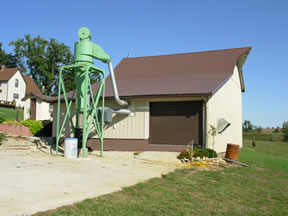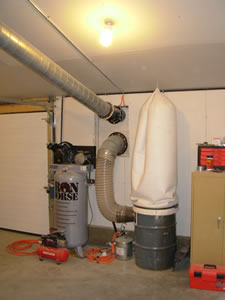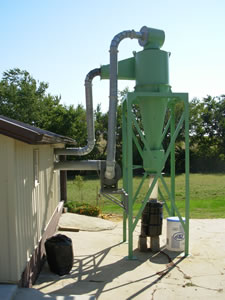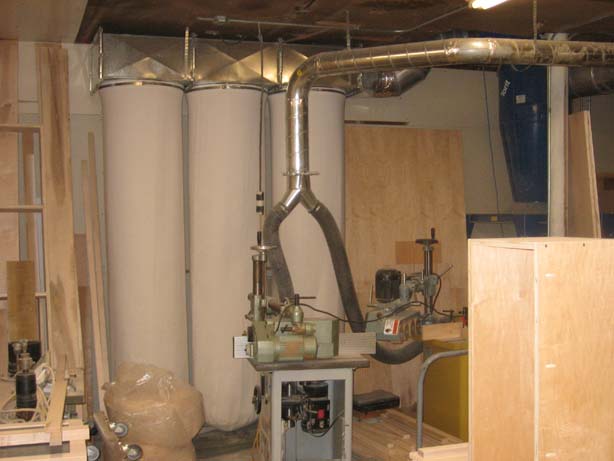Cyclone Dust Collector Example
Here are some nice photos and well-informed discussion of a small-shop cyclone dust collector setup. March 3, 2010
Question
Here are a few pictures of my cyclone dust collector that I have recently finished at my new custom cabinet business. I am posting them to serve as an example for others that may want to do something similar. Also I am kind of proud of my setup. Although this setup is not complete I plan on eliminating the small barrel under the cyclone and putting a large container on a trailer axle. Hopefully I can get this done when I have time or when I get tired of emptying barrels. Any comments or suggestions are appreciated and I hope these pictures serve as an example.

Inside Picture

Outside Picture

Forum Responses
(Dust Collection and Safety Equipment Forum)
From contributor J:
Nice to get a beast like that outside, but I'm wondering about the exhaust line back into the shop. It looks as if you reduced it an awful lot to make the return ductwork easier, and that could hurt the performance. Is it working well?
From contributor J:
I'd also be worried about the filtration of exhaust air. The bag you've got on that drum inside the shop looks like one intended for a much smaller machine.
From contributor F:
I am also worried about your return filtration. My cyclone is a 24" w/ a 7-1/2 hp motor, and I run 3 filter bags 24" diameter. by 8' high. Your’s looks way too small for the size of the cyclone. If you’re in a warmer climate you could do away with the return filter altogether.
I think your idea for mounting to a trailer is a good one, wish I could do it myself.
Something else to watch out for, if you don't already know, is if you fill your collector barrel without knowing the cyclone will blow all your chips right into your filter. I mention that since your barrel is outside, "out of site, out of mind". Good to see dc being addressed the right way in a new shop. Too many small shops using those junk 1-1/2 hp roll around units that aren't up to the task. Hopefully this post will encourage others to take their dc more seriously.
From the original questioner:
The system works great. Yes I did have to reduce the piping down a lot but I have a system I can grow into as my business grows. I actually bought the cyclone off eBay, when I went to pick it up I was amazed by the size of it. It was much larger that I had anticipated. This cyclone actually came from a very large manufacturing facility. The cyclone actually sat inside toward the middle of the plant and the blower was outside about 300' away.
I have been thinking about adding another barrel and filter bag. Today I took my flex hose loose from the barrel and I gained quite a bit of suction. So I am going to add another barrel and filter bag. Thanks for the comments and suggestions, keep them coming.
From contributor F:
Just an FYI, you don't really need the barrels inside, just the bags. If your system is working properly all you'll get in the bags is very fine dust. This can be shaken out every couple of months (depending on how much you use your collector) and emptied into a smaller container. For a small one man shop it will take you years to fill the barrels. It's better to have the extra filter area than an extra drum which won't do much for you.
Here’s an example.

Click here for higher quality, full size image
From contributor P:
You might be better off without the bags. Check the return air temperature. It might be hotter than the outside temperature in the summer, and cooler in the winter. If this is the case, it may be cheaper to heat make up air than it is to heat return air. Also, the makeup air is cleaner than the filtered air. I worked in a shop that had an 18" metal dust collection pipe running over a metal roof to a cyclone in an unheated area. The solar heating was great, except it was during the summer. The blast of cold return air in the winter wasn't refreshing. If you have a one person shop, the amount of time the blower runs changes the math on using outdoor make up air for the blower.
From the original questioner:
To contributor P: I know what you’re talking about. I have thought about just eliminating the return line and blowing it outside, especially since I have radiant in-floor heat. I don't think I would lose a lot of heat in the winter because the radiant heat doesn't heat the air it heats the objects in the room. I just might have to try experimenting with it this winter.
From contributor K:
If you decide to continue re-circulating filtered air to your shop, I would recommend increasing your filter capacity. Standard for general woodworking is a 10 to 1 ratio of cfm to square feet of filter media, lower if you are producing a lot of fine dust from sanding. The amount of fine dust escaping from the filters is directly related to the velocity through them, which in turn is related to their total area. What you have right now is a dust pump that removes the large particles and puts the fines back into the shop atmosphere.



